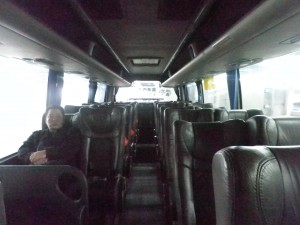Took bus 606 to Wuhan University. A big proportion of bus drivers in China are female and this lady was wearing a high heel shoe navigating the bus.
![P2043657 [640x480]](http://journey26.com/blog/wp-content/uploads/2010/02/P2043657-640x480-225x300.jpg)
Wuhan University
![P2043663 [640x480]](http://journey26.com/blog/wp-content/uploads/2010/02/P2043663-640x480-300x225.jpg)
![P2043662 [640x480]](http://journey26.com/blog/wp-content/uploads/2010/02/P2043662-640x480-300x225.jpg)
Took bus 413 to DongHu (East Lake)
![P2043667 [640x480]](http://journey26.com/blog/wp-content/uploads/2010/02/P2043667-640x480-300x225.jpg)
![P2043668 [640x480]](http://journey26.com/blog/wp-content/uploads/2010/02/P2043668-640x480-300x225.jpg)
and MoShan.
![P2043665 [640x480]](http://journey26.com/blog/wp-content/uploads/2010/02/P2043665-640x480-300x225.jpg)
Took bus 401 all the way from the eastern part of Wuchang to the last stop at HanYang district.
![P2043672 [640x480]](http://journey26.com/blog/wp-content/uploads/2010/02/P2043672-640x480-300x225.jpg)
Visited Wuhan uprising museum.
![P2043676 [640x480]](http://journey26.com/blog/wp-content/uploads/2010/02/P2043676-640x480-300x225.jpg)
During Oct 10th 1911, Wuchang Uprising broke out and that led to the collapse of the Qing Dynasty and the establishment of the Republic of China.
The left is the military flag during that time and the right is the 5 color flag of Republic of China then. The five colors are representing the five major nationalities of China, the Han (red), the Manchu (yellow), the Mongol (blue), the Hui (white), and the Tibetan (black).
![P2043687 [640x480]](http://journey26.com/blog/wp-content/uploads/2010/02/P2043687-640x480-225x300.jpg)
Decided to take the high speed train (GaoTie) to Changsha instead of the normal one. From Wuhan to Changsha it’s around 350 km. Normal fast train takes around 3.5 hours (58 Yuan) and the high speed train (175 Yuan) will take only 80 minutes. Actually it will take almost the same amount of time to get to Changsha from Wuhan because the high speed train runs from the new Wuhan station located at the northeastern part of Wuchang which is a far from Wuchang city center to the new Changsha south station located at the south eastern part of Changsha which is also far from Changsha city center. To get to the new Wuhan train station, it will take almost an hour by public bus. Took bus 315 and switched to bus 311 to get to the new Wuhan station.
![P2043695 [640x480]](http://journey26.com/blog/wp-content/uploads/2010/02/P2043695-640x480-300x225.jpg)
![P2043698 [640x480]](http://journey26.com/blog/wp-content/uploads/2010/02/P2043698-640x480-300x225.jpg)
![P2043700 [640x480]](http://journey26.com/blog/wp-content/uploads/2010/02/P2043700-640x480-300x225.jpg)
There is bullet train every 20 minutes from Wuhan to Guangzhou.
![P2043693 [640x480]](http://journey26.com/blog/wp-content/uploads/2010/02/P2043693-640x480-300x225.jpg)
Infrastructure project in China are amazing. The country is modernizing its infrastructures in a rapid pace and the train station look first class. However, behavior of human is hard to change and still needs time. The floor in the station is super clean but people still throw guazipi (skin of sunflower seeds) on the floor.
![P2043701 [640x480]](http://journey26.com/blog/wp-content/uploads/2010/02/P2043701-640x480-225x300.jpg)
Got on the G1059 5.40pm train (175 Yuan~USD$26). For high speed train, it cost roughly around USD$9 for every half an hour ride.
![P2043704 [640x480]](http://journey26.com/blog/wp-content/uploads/2010/02/P2043704-640x480-300x225.jpg)
![P2043705 [640x480]](http://journey26.com/blog/wp-content/uploads/2010/02/P2043705-640x480-300x225.jpg)
![P2043708 [640x480]](http://journey26.com/blog/wp-content/uploads/2010/02/P2043708-640x480-300x225.jpg)
![P2043714 [640x480]](http://journey26.com/blog/wp-content/uploads/2010/02/P2043714-640x480-300x225.jpg)
The top speed is over 350km/h.
![P2043718 [640x480]](http://journey26.com/blog/wp-content/uploads/2010/02/P2043718-640x480-300x225.jpg)
The train arrived at Changsha sharp at 7.08pm. The bullet train is similar to a metro system, the train stopped at in between stations on the way for less than a minute.
Automated exit procedure.
![P2043720 [640x480]](http://journey26.com/blog/wp-content/uploads/2010/02/P2043720-640x480-300x225.jpg)
Automated ticket machine.
![P2043724 [640x480]](http://journey26.com/blog/wp-content/uploads/2010/02/P2043724-640x480-225x300.jpg)
Changsha south station.
![P2043725 [640x480]](http://journey26.com/blog/wp-content/uploads/2010/02/P2043725-640x480-300x225.jpg)
It’s weird that the south station only sells high speed train ticket. The new south station is quite far from the city center. Took a bus to the main train station in the city and switched to bus 132 to XiaDaLong stop in order to get to Changsha Hostel (35 Yuan~USD$5).
![P2053736 [640x480]](http://journey26.com/blog/wp-content/uploads/2010/02/P2053736-640x480-300x225.jpg)
I was surprise to meet LingChao again at the hostel. We just met few weeks ago at a hostel in Beijing. He is from Changsha so he was my guide and brought me to try out Hunan cuisine which is called XiangCai.
On the left is LuShuiShiHeYi (4 combination) and right is a kind of spicy shrimp. Hunan cuisine is spicy and actually Sichuan cuisine originated from the combination of GuangDong cuisine and Hunan cuisine.
![P2043728 [640x480]](http://journey26.com/blog/wp-content/uploads/2010/02/P2043728-640x480-300x225.jpg)
HuoGongDian is one of Mao’s favorite restaurant.
![P2043729 [640x480]](http://journey26.com/blog/wp-content/uploads/2010/02/P2043729-640x480-300x225.jpg)
Mao loves stinky tofu and he mentioned that HuoGongDian’s Tofu smells bad but it tastes good.
![P2043730 [640x480]](http://journey26.com/blog/wp-content/uploads/2010/02/P2043730-640x480-300x225.jpg)
Changsha is famous for its bar culture. There are many bars around the city and this is one of the bar street, HuaLongChi.
![P2043731 [640x480]](http://journey26.com/blog/wp-content/uploads/2010/02/P2043731-640x480-225x300.jpg)
![P2043734 [640x480]](http://journey26.com/blog/wp-content/uploads/2010/02/P2043734-640x480-300x225.jpg)
![P2083813 [640x480]](http://journey26.com/blog/wp-content/uploads/2010/02/P2083813-640x480-300x225.jpg)
![P2083816 [640x480]](http://journey26.com/blog/wp-content/uploads/2010/02/P2083816-640x480-225x300.jpg)

![P2083818 [640x480]](http://journey26.com/blog/wp-content/uploads/2010/02/P2083818-640x480-300x225.jpg)
![P2083820 [640x480]](http://journey26.com/blog/wp-content/uploads/2010/02/P2083820-640x480-300x225.jpg)
![P2083824 [640x480]](http://journey26.com/blog/wp-content/uploads/2010/02/P2083824-640x480-300x225.jpg)
![P2083835 [640x480]](http://journey26.com/blog/wp-content/uploads/2010/02/P2083835-640x480-300x225.jpg)
![P2083822 [640x480]](http://journey26.com/blog/wp-content/uploads/2010/02/P2083822-640x480-300x225.jpg)
![P2083828 [640x480]](http://journey26.com/blog/wp-content/uploads/2010/02/P2083828-640x480-300x225.jpg)
![P2083839 [640x480]](http://journey26.com/blog/wp-content/uploads/2010/02/P2083839-640x480-300x225.jpg)
![P2083841 [640x480]](http://journey26.com/blog/wp-content/uploads/2010/02/P2083841-640x480-300x225.jpg)
![P2083842 [640x480]](http://journey26.com/blog/wp-content/uploads/2010/02/P2083842-640x480-300x225.jpg)
![P2073799 [640x480]](http://journey26.com/blog/wp-content/uploads/2010/02/P2073799-640x480-300x225.jpg)
![P2073802 [640x480]](http://journey26.com/blog/wp-content/uploads/2010/02/P2073802-640x480-300x225.jpg)
![P2073804 [640x480]](http://journey26.com/blog/wp-content/uploads/2010/02/P2073804-640x480-300x225.jpg)
![P2073808 [640x480]](http://journey26.com/blog/wp-content/uploads/2010/02/P2073808-640x480-300x225.jpg)
![P2063780 [640x480]](http://journey26.com/blog/wp-content/uploads/2010/02/P2063780-640x480-300x225.jpg)
![P2063782 [640x480]](http://journey26.com/blog/wp-content/uploads/2010/02/P2063782-640x480-300x225.jpg)
![P2063784 [640x480]](http://journey26.com/blog/wp-content/uploads/2010/02/P2063784-640x480-300x225.jpg)
![P2063792 [640x480]](http://journey26.com/blog/wp-content/uploads/2010/02/P2063792-640x480-300x225.jpg)
![P2063794 [640x480]](http://journey26.com/blog/wp-content/uploads/2010/02/P2063794-640x480-300x225.jpg)
![P2053737 [640x480]](http://journey26.com/blog/wp-content/uploads/2010/02/P2053737-640x480-300x225.jpg)
![P2053738 [640x480]](http://journey26.com/blog/wp-content/uploads/2010/02/P2053738-640x480-300x225.jpg)
![P2053741 [640x480]](http://journey26.com/blog/wp-content/uploads/2010/02/P2053741-640x480-300x225.jpg)
![P2053740 [640x480]](http://journey26.com/blog/wp-content/uploads/2010/02/P2053740-640x480-300x225.jpg)
![P2053742 [640x480]](http://journey26.com/blog/wp-content/uploads/2010/02/P2053742-640x480-300x225.jpg)
![P2053746 [640x480]](http://journey26.com/blog/wp-content/uploads/2010/02/P2053746-640x480-300x225.jpg)
![P2053747 [640x480]](http://journey26.com/blog/wp-content/uploads/2010/02/P2053747-640x480-300x225.jpg)
![P2053749 [640x480]](http://journey26.com/blog/wp-content/uploads/2010/02/P2053749-640x480-300x225.jpg)
![P2053750 [640x480]](http://journey26.com/blog/wp-content/uploads/2010/02/P2053750-640x480-300x225.jpg)
![P2053754 [640x480]](http://journey26.com/blog/wp-content/uploads/2010/02/P2053754-640x480-300x225.jpg)
![P2053755 [640x480]](http://journey26.com/blog/wp-content/uploads/2010/02/P2053755-640x480-300x225.jpg)
![P2053756 [640x480]](http://journey26.com/blog/wp-content/uploads/2010/02/P2053756-640x480-300x225.jpg)
![P2053758 [640x480]](http://journey26.com/blog/wp-content/uploads/2010/02/P2053758-640x480-300x225.jpg)
![P2053759 [640x480]](http://journey26.com/blog/wp-content/uploads/2010/02/P2053759-640x480-300x225.jpg)
![P2053765 [640x480]](http://journey26.com/blog/wp-content/uploads/2010/02/P2053765-640x480-300x225.jpg)
![P2053769 [640x480]](http://journey26.com/blog/wp-content/uploads/2010/02/P2053769-640x480-300x225.jpg)
![P2053770 [640x480]](http://journey26.com/blog/wp-content/uploads/2010/02/P2053770-640x480-300x225.jpg)
![P2053774 [640x480]](http://journey26.com/blog/wp-content/uploads/2010/02/P2053774-640x480-300x225.jpg)
![P2053775 [640x480]](http://journey26.com/blog/wp-content/uploads/2010/02/P2053775-640x480-300x225.jpg)
![P2053776 [640x480]](http://journey26.com/blog/wp-content/uploads/2010/02/P2053776-640x480-300x225.jpg)
![P2053777 [640x480]](http://journey26.com/blog/wp-content/uploads/2010/02/P2053777-640x480-300x225.jpg)
![P2043657 [640x480]](http://journey26.com/blog/wp-content/uploads/2010/02/P2043657-640x480-225x300.jpg)
![P2043663 [640x480]](http://journey26.com/blog/wp-content/uploads/2010/02/P2043663-640x480-300x225.jpg)
![P2043662 [640x480]](http://journey26.com/blog/wp-content/uploads/2010/02/P2043662-640x480-300x225.jpg)
![P2043667 [640x480]](http://journey26.com/blog/wp-content/uploads/2010/02/P2043667-640x480-300x225.jpg)
![P2043668 [640x480]](http://journey26.com/blog/wp-content/uploads/2010/02/P2043668-640x480-300x225.jpg)
![P2043665 [640x480]](http://journey26.com/blog/wp-content/uploads/2010/02/P2043665-640x480-300x225.jpg)
![P2043672 [640x480]](http://journey26.com/blog/wp-content/uploads/2010/02/P2043672-640x480-300x225.jpg)
![P2043676 [640x480]](http://journey26.com/blog/wp-content/uploads/2010/02/P2043676-640x480-300x225.jpg)
![P2043687 [640x480]](http://journey26.com/blog/wp-content/uploads/2010/02/P2043687-640x480-225x300.jpg)
![P2043695 [640x480]](http://journey26.com/blog/wp-content/uploads/2010/02/P2043695-640x480-300x225.jpg)
![P2043698 [640x480]](http://journey26.com/blog/wp-content/uploads/2010/02/P2043698-640x480-300x225.jpg)
![P2043700 [640x480]](http://journey26.com/blog/wp-content/uploads/2010/02/P2043700-640x480-300x225.jpg)
![P2043693 [640x480]](http://journey26.com/blog/wp-content/uploads/2010/02/P2043693-640x480-300x225.jpg)
![P2043701 [640x480]](http://journey26.com/blog/wp-content/uploads/2010/02/P2043701-640x480-225x300.jpg)
![P2043704 [640x480]](http://journey26.com/blog/wp-content/uploads/2010/02/P2043704-640x480-300x225.jpg)
![P2043705 [640x480]](http://journey26.com/blog/wp-content/uploads/2010/02/P2043705-640x480-300x225.jpg)
![P2043708 [640x480]](http://journey26.com/blog/wp-content/uploads/2010/02/P2043708-640x480-300x225.jpg)
![P2043714 [640x480]](http://journey26.com/blog/wp-content/uploads/2010/02/P2043714-640x480-300x225.jpg)
![P2043718 [640x480]](http://journey26.com/blog/wp-content/uploads/2010/02/P2043718-640x480-300x225.jpg)
![P2043720 [640x480]](http://journey26.com/blog/wp-content/uploads/2010/02/P2043720-640x480-300x225.jpg)
![P2043724 [640x480]](http://journey26.com/blog/wp-content/uploads/2010/02/P2043724-640x480-225x300.jpg)
![P2043725 [640x480]](http://journey26.com/blog/wp-content/uploads/2010/02/P2043725-640x480-300x225.jpg)
![P2053736 [640x480]](http://journey26.com/blog/wp-content/uploads/2010/02/P2053736-640x480-300x225.jpg)
![P2043728 [640x480]](http://journey26.com/blog/wp-content/uploads/2010/02/P2043728-640x480-300x225.jpg)
![P2043729 [640x480]](http://journey26.com/blog/wp-content/uploads/2010/02/P2043729-640x480-300x225.jpg)
![P2043730 [640x480]](http://journey26.com/blog/wp-content/uploads/2010/02/P2043730-640x480-300x225.jpg)
![P2043731 [640x480]](http://journey26.com/blog/wp-content/uploads/2010/02/P2043731-640x480-225x300.jpg)
![P2043734 [640x480]](http://journey26.com/blog/wp-content/uploads/2010/02/P2043734-640x480-300x225.jpg)
![P2033597 [640x480]](http://journey26.com/blog/wp-content/uploads/2010/02/P2033597-640x480-300x225.jpg)
![P2033598 [640x480]](http://journey26.com/blog/wp-content/uploads/2010/02/P2033598-640x480-300x225.jpg)
![P2033600 [640x480]](http://journey26.com/blog/wp-content/uploads/2010/02/P2033600-640x480-300x225.jpg)
![P2033602 [640x480]](http://journey26.com/blog/wp-content/uploads/2010/02/P2033602-640x480-300x225.jpg)
![P2033603 [640x480]](http://journey26.com/blog/wp-content/uploads/2010/02/P2033603-640x480-300x225.jpg)
![P2033604 [640x480]](http://journey26.com/blog/wp-content/uploads/2010/02/P2033604-640x480-300x225.jpg)
![P2033625 [640x480]](http://journey26.com/blog/wp-content/uploads/2010/02/P2033625-640x480-300x225.jpg)
![P2033608 [640x480]](http://journey26.com/blog/wp-content/uploads/2010/02/P2033608-640x480-300x225.jpg)
![P2033615 [640x480]](http://journey26.com/blog/wp-content/uploads/2010/02/P2033615-640x480-300x225.jpg)
![P2033629 [640x480]](http://journey26.com/blog/wp-content/uploads/2010/02/P2033629-640x480-300x225.jpg)
![P2033638 [640x480]](http://journey26.com/blog/wp-content/uploads/2010/02/P2033638-640x480-300x225.jpg)
![P2033633 [640x480]](http://journey26.com/blog/wp-content/uploads/2010/02/P2033633-640x480-300x225.jpg)
![P2033640 [640x480]](http://journey26.com/blog/wp-content/uploads/2010/02/P2033640-640x480-300x225.jpg)
![P2033641 [640x480]](http://journey26.com/blog/wp-content/uploads/2010/02/P2033641-640x480-300x225.jpg)
![P2033643 [640x480]](http://journey26.com/blog/wp-content/uploads/2010/02/P2033643-640x480-300x225.jpg)
![P2033650 [640x480]](http://journey26.com/blog/wp-content/uploads/2010/02/P2033650-640x480-300x225.jpg)
![P2033653 [640x480]](http://journey26.com/blog/wp-content/uploads/2010/02/P2033653-640x480-300x225.jpg)
![P2023553 [640x480]](http://journey26.com/blog/wp-content/uploads/2010/02/P2023553-640x480-300x225.jpg)
![P2023554 [640x480]](http://journey26.com/blog/wp-content/uploads/2010/02/P2023554-640x480-300x225.jpg)
![P2023555 [640x480]](http://journey26.com/blog/wp-content/uploads/2010/02/P2023555-640x480-225x300.jpg)
![P2023558 [640x480]](http://journey26.com/blog/wp-content/uploads/2010/02/P2023558-640x480-300x225.jpg)
![P2023559 [640x480]](http://journey26.com/blog/wp-content/uploads/2010/02/P2023559-640x480-300x225.jpg)
![P2023561 [640x480]](http://journey26.com/blog/wp-content/uploads/2010/02/P2023561-640x480-300x225.jpg)
![P2023560 [640x480]](http://journey26.com/blog/wp-content/uploads/2010/02/P2023560-640x480-300x225.jpg)
![P2023562 [640x480]](http://journey26.com/blog/wp-content/uploads/2010/02/P2023562-640x480-225x300.jpg)
![P2023565 [640x480]](http://journey26.com/blog/wp-content/uploads/2010/02/P2023565-640x480-225x300.jpg)
![P2023568 [640x480]](http://journey26.com/blog/wp-content/uploads/2010/02/P2023568-640x480-300x225.jpg)
![P2023574 [640x480]](http://journey26.com/blog/wp-content/uploads/2010/02/P2023574-640x480-225x300.jpg)
![P2023572 [640x480]](http://journey26.com/blog/wp-content/uploads/2010/02/P2023572-640x480-300x225.jpg)
![P2023588 [640x480]](http://journey26.com/blog/wp-content/uploads/2010/02/P2023588-640x480-300x225.jpg)
![P2023591 [640x480]](http://journey26.com/blog/wp-content/uploads/2010/02/P2023591-640x480-300x225.jpg)
![P2013515 [640x480]](http://journey26.com/blog/wp-content/uploads/2010/02/P2013515-640x480-300x225.jpg)
![P2013518 [640x480]](http://journey26.com/blog/wp-content/uploads/2010/02/P2013518-640x480-225x300.jpg)
![P2013520 [640x480]](http://journey26.com/blog/wp-content/uploads/2010/02/P2013520-640x480-300x225.jpg)
![P2013526 [640x480]](http://journey26.com/blog/wp-content/uploads/2010/02/P2013526-640x4801-300x225.jpg)
![P2013528 [640x480]](http://journey26.com/blog/wp-content/uploads/2010/02/P2013528-640x480-300x225.jpg)
![P2013538 [640x480]](http://journey26.com/blog/wp-content/uploads/2010/02/P2013538-640x480-300x225.jpg)
![P2013542 [640x480]](http://journey26.com/blog/wp-content/uploads/2010/02/P2013542-640x480-300x225.jpg)
![P2013546 [640x480]](http://journey26.com/blog/wp-content/uploads/2010/02/P2013546-640x480-300x225.jpg)